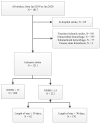Determinants of Prolonged Length of Hospital Stay in Patients with Severe Acute Ischemic Stroke
- PMID: 35743530
- PMCID: PMC9225000
- DOI: 10.3390/jcm11123457
Determinants of Prolonged Length of Hospital Stay in Patients with Severe Acute Ischemic Stroke
Abstract
Objective: Long hospitalizations are associated with a high comorbidity and considerable hospital cost. Admissions of severe acute ischemic stroke are prone to longer hospitalizations. We aimed to explore the issue and method for improving the length of stay.
Methods: From the prospective Stroke Registry between January 2019 and June 2020, acute ischemic strokes with an admission National Institutes of Health Stroke Scale ≥ 15 were identified. Prolonged length-of-stay was defined as in-hospital-stay ≥ 30 days. All clinical characteristics were collected, and all do-not-resuscitate documentations were categorized if the order had been written within 7 days of onset.
Results: A total of 212 patients were eligible for severe stroke. Of these, 42 (19.8%) had prolonged length-of-stay and 170 had non-prolonged length-of-stay (median 43 vs. 13 days). The prolonged group was younger, mostly men, and was more likely to be in an independent state and more likely to receive reperfusion therapy, and there was a higher frequency of late do-not-resuscitate orders if signed. Although there was a lower in-hospital mortality rate in the prolonged group (12% vs. 23%), there was a higher proportion with a severe functional state (Modified Rankin Scale = 4-5) among the survivors (97% vs. 87%).
Conclusions: Severe acute ischemic stroke patients with a prolonged length-of-stay were younger, mostly male, more likely to receive reperfusion therapy, less likely to have an early do-not-resuscitate order if signed, and more likely to have poor functional status at discharge, although there was a lower rate of in-hospital mortality.
Keywords: do-not-resuscitate; functional outcome; length of hospital stay; prolonged length of stay; severe acute ischemic stroke.
Conflict of interest statement
The authors declare no conflict of interest.
Figures
References
-
- Marfil-Garza B.A., Belaunzaran-Zamudio P.F., Gulias-Herrero A., Zuniga A.C., Caro-Vega Y., Kershenobich-Stalnikowitz D., Sifuentes-Osornio J. Risk factors associated with prolonged hospital length-of-stay: 18-year retrospective study of hospitalizations in a tertiary healthcare center in Mexico. PLoS ONE. 2018;13:e0207203. - PMC - PubMed
LinkOut - more resources
Full Text Sources



